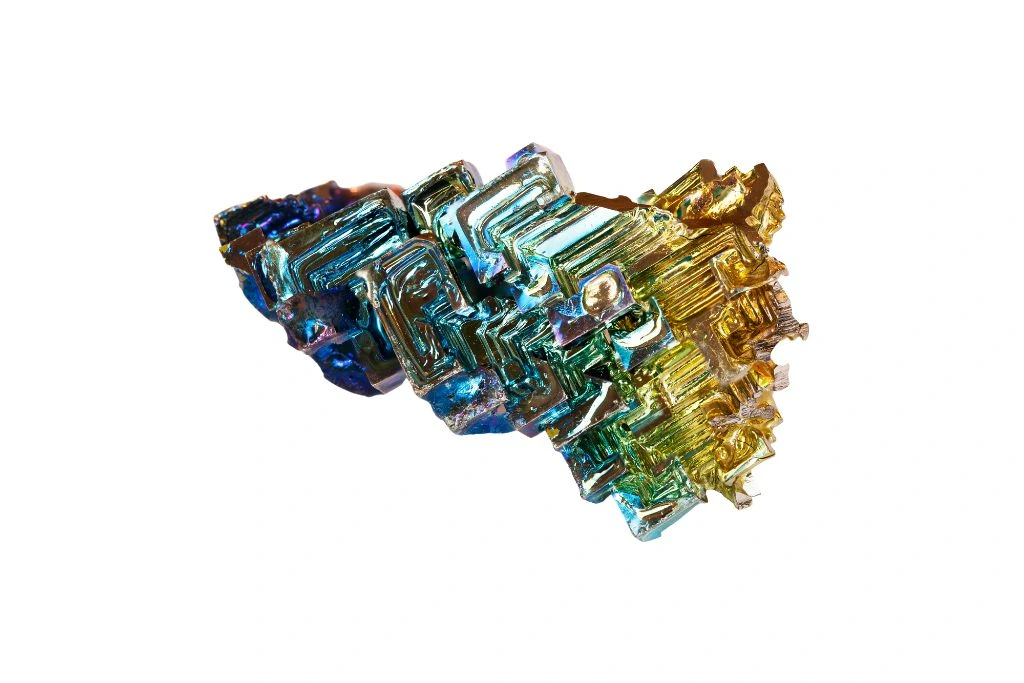The Distinctive Appearance of Bismuth
Bismuth is a striking and visually captivating element that stands out among crystalline structures. Its most notable characteristic is its iridescent, rainbow-like coloration. The surface of bismuth crystals displays a mesmerizing array of colors, including vibrant hues of blue, purple, gold, and orange. This dazzling effect is caused by the oxidation of the crystal’s surface, which creates thin films that reflect light at different wavelengths.
Geometric Structure
One of the most fascinating aspects of bismuth is its unique geometric structure. Bismuth crystals form in a distinctive stair-step pattern, creating intricate, three-dimensional shapes. These structures often resemble miniature cityscapes or futuristic architectural designs. The crystals typically grow in a spiral formation, with each new layer building upon the previous one to create a mesmerizing, fractal-like appearance.
Physical Properties
Bismuth is a brittle metal with a low melting point of 520.6°F (271.4°C). In its solid form, it has a silvery-white appearance with a slight pinkish tinge. When exposed to air, bismuth quickly develops a thin oxide layer, which is responsible for its iridescent coloration. The crystal structure of bismuth is rhombohedral, belonging to the trigonal crystal system. This unique structure contributes to its distinctive appearance and growth patterns.
Unique Features
One of the most remarkable features of bismuth is its ability to form hopper crystals. These crystals have a hollow, step-like structure that resembles an inverted pyramid or staircase. This peculiar growth pattern occurs due to rapid crystallization, where the edges of the crystal grow faster than the center. The result is a captivating, geometric formation that sets bismuth apart from other crystalline structures. Additionally, bismuth has the unusual property of expanding as it solidifies, making it one of the few substances that is denser in its liquid state than in its solid state.
Historical and Cultural Significance of Bismuth
Bismuth has been known since ancient times, often confused with tin and lead due to its similar appearance. Alchemists in the Middle Ages were fascinated by bismuth’s unique properties and considered it a possible ingredient in the philosopher’s stone. In the 18th century, bismuth gained importance in the pharmaceutical industry, marking the beginning of its medicinal applications.
Metaphysical Associations
In crystal healing and metaphysical practices, bismuth is associated with transformation and spiritual growth. Its iridescent, spiral-like crystals are believed to represent the evolution of the soul and the journey towards higher consciousness. Bismuth is thought to enhance creativity, intuition, and imagination, making it a popular choice for artists and those seeking inspiration.
Common Uses and Applications
Bismuth has a wide range of practical applications in modern times. It is a key ingredient in many pharmaceuticals, particularly those used to treat digestive issues like ulcers and acid reflux. In the cosmetics industry, bismuth oxychloride is used in makeup products for its pearlescent effect. Bismuth is also used in fire safety devices, as it has a low melting point and expands upon solidification, making it ideal for triggering sprinkler systems.
Benefits and Healing Properties
Proponents of crystal healing believe that bismuth can provide numerous benefits. It is said to alleviate feelings of isolation and loneliness, promote vitality, and reduce fatigue. Some claim that bismuth can help with digestive issues, aligning with its use in conventional medicine. Additionally, bismuth is thought to enhance mental clarity and focus, making it popular among students and professionals seeking improved cognitive function.

